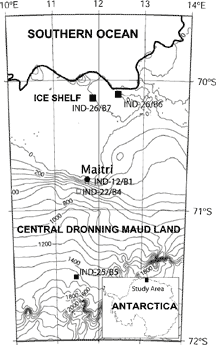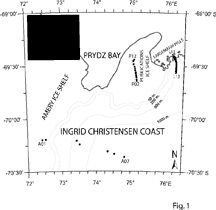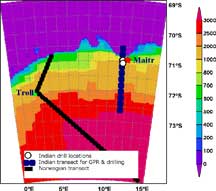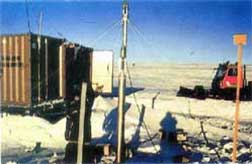
Indian National Report - Acitivities 2007
January 2008
Prepared by: Thamban Meloth (meloth at ncaor.org)
In order to assess the spatial and temporal variations in the chemical characteristics of snow and ice within the coastal Antarctica with respect to the contributions from sea spray, marine biological productivity and/or volcanic eruptions, India has initiated sampling of surface snow and shallow depth (<100 m) ice cores along a coastal to inland transect in the East Antarctica.

Field Campaign
Indian ice core drilling reached another milestone during 2006-07. This campaign being part of the long-term collaborative program between National Centre for Antarctic & Ocean Research (NCAOR), Goa and Geological Survey of India (GSI), Faridabad, completed a successful ice core drilling season in the Central Dronning Maud Land (CDML) region. The first core was collected during the November to December 2006 in the ice shelf at a location of 70º11'57.4" S latitude & 12º27' 25.1" E longitude and the ice cores were recovered to a depth of 75 m. The second bore hole was also within the ice shelf region during February 2007 (Location: 70º 13.804’ S & 11º 55.738’ E) and recovered an ice core up to 55 m depth each in the ice shelf region (Fig. 1). Drilling was done using an electromechanical device. All the recovered ice cores were properly packed and labeled in clean LDPE rolls and safely stored in Expanded Poly Propylene (EPP) boxes and shipped under subzero (−20°C) conditions onboard the M/V Emerald Sea to the ice core lab at NCAOR, Goa.
 Along the Ingrid Christensen Coast, systematic sampling of surface
snow was carried out along three coastal to inland transects of Larsemann Hills region and adjoining ice shelves like the Amery Ice Shelf and Publications
Ice Shelf during March 2007. Snow sampling, following clean methods, was made along three transects in different regions. Of these, the first one included
a set of 36 samples from the various hills around the proposed Indian station location and a roughly 76º 16’ E coastal to inland transect
along the adjacent polar ice cap (Lat 69º24’ S to 69º29’ S). The second coastal to inland transect along 75º05’ E was
carried out within the Publications Ice Shelf with collection of 12 representative samples (Lat 69º26’ S to 69º38’ S). The region
was highly crevasse-ridden and helicopter support was extremely essential for the sampling. Although several attempts were made to sample along the entire
Amery Ice Shelf, the weather conditions within the shelf made the sampling very difficult. In case of Amery transect, due to poor weather and logistic
constraints, only 7 samples could be collected that too along a diagonal transect ~100 km starting from the Amery ice shelf extending to the inland glaciers
(Lat 69º32’ S to 70º21’ S).
Along the Ingrid Christensen Coast, systematic sampling of surface
snow was carried out along three coastal to inland transects of Larsemann Hills region and adjoining ice shelves like the Amery Ice Shelf and Publications
Ice Shelf during March 2007. Snow sampling, following clean methods, was made along three transects in different regions. Of these, the first one included
a set of 36 samples from the various hills around the proposed Indian station location and a roughly 76º 16’ E coastal to inland transect
along the adjacent polar ice cap (Lat 69º24’ S to 69º29’ S). The second coastal to inland transect along 75º05’ E was
carried out within the Publications Ice Shelf with collection of 12 representative samples (Lat 69º26’ S to 69º38’ S). The region
was highly crevasse-ridden and helicopter support was extremely essential for the sampling. Although several attempts were made to sample along the entire
Amery Ice Shelf, the weather conditions within the shelf made the sampling very difficult. In case of Amery transect, due to poor weather and logistic
constraints, only 7 samples could be collected that too along a diagonal transect ~100 km starting from the Amery ice shelf extending to the inland glaciers
(Lat 69º32’ S to 70º21’ S).
Field team: Thamban Meloth (NCAOR), P. K. Shrivastava (GSI), P. C. George (GSI)
Analysis & Data:
Surface snow samples collected from the coastal region of Ingrid Christensen Coast were analysed for various glacio-chemical and stable isotope constituents. Data suggest that the sea salt constituents reveal a dramatic reduction from the coastal to inland sites. Evaluation of various sea spray components reveals significant deviation from the reference sea water values, suggesting the importance of fractionation here. Further, the large nssSO42- depletion found in the ice edge samples suggest that the extreme fractionation in the sulphate occurs even during the summer and serious underestimation can arise in the assessment of summer atmospheric sulphate budget within the coastal Antarctica.
Collaborations:
Active interaction is made between the Asian countries (especially Japan) under the aegis of AFoPS (Asian Forum on Polar Sciences). India is also looking forward for field and laboratory co-operation with US Chile and Brazil on a shallow ice core drilling program in the Antarctic Peninsula.

Fig. 1. Locations of ice cores recently
drilled by Indian scientists and the proposed
Indian traverse.

Fig. 2. Ice core drilling activity in CDML
during 2003 by Indian scientists Indian National Report January 2006 Indian National Report January 2007
